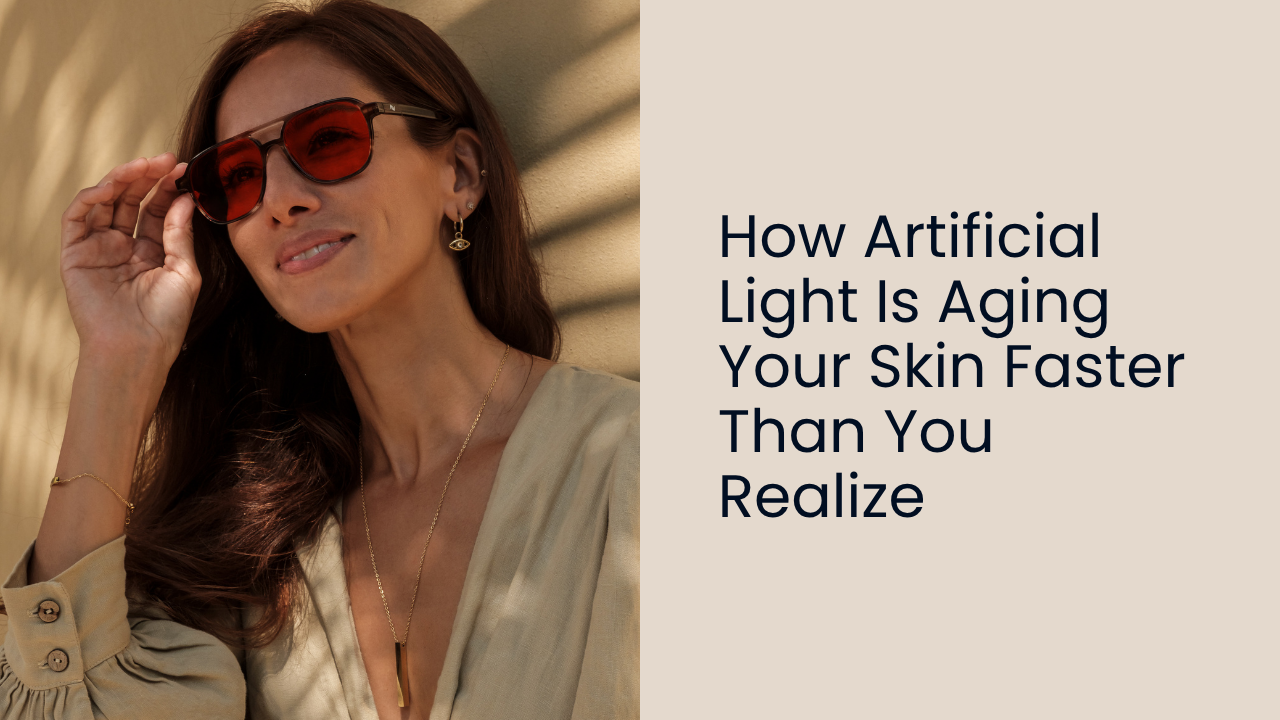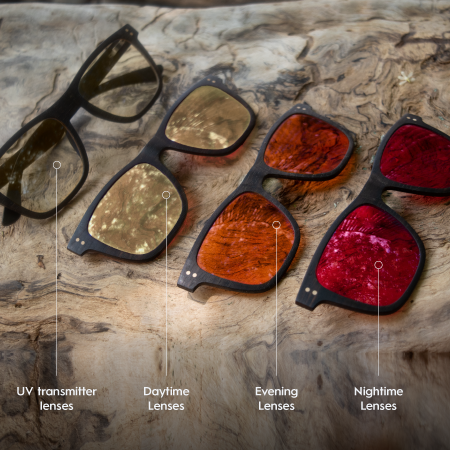How Artificial Light Is Aging Your Skin Faster Than You Realize (And Why Your Expensive Creams Can't Fix It)

Last week, a 45-year-old woman sat across from me, exhausted and frustrated.
She'd just dropped $400 that month on anti-aging products. Retinol serum. Vitamin C. Peptide cream. Collagen supplements. NAD+ boosters. She was even researching Botox clinics.
"I'm doing everything right," she said, her voice cracking slightly. "But I still look tired. My skin looks... dull. And I can't seem to shake this exhaustion."
I asked her two simple questions:
"What time do you go to sleep?"
"Midnight, usually. Sometimes 1 AM if I'm scrolling through my phone to decompress."
"Do you use your phone in bed?"
"Of course. How else am I supposed to wind down?"
Here's what I told her—and what changed everything:
Your expensive creams are trying to repair damage that's being created every single night while you're exposed to artificial light.
The beauty industry is selling you expensive band-aids for a wound that never stops bleeding.
Because while you're investing hundreds in serums and supplements, there's a fundamental biological process being disrupted inside your body that no cream, supplement, or injection can overcome.
The solution isn't another product. It isn't complicated. It isn't expensive.
It's understanding what your skin needs to repair itself—and finally giving it the right conditions.
Skin Aging: What You Can Actually See
You stand in front of the bathroom mirror in the morning light.
There they are again, those dark circles under your eyes that concealer can't quite hide. The fine lines that seem deeper than yesterday. That overall dullness, like someone turned down the brightness on your face.
You've been so good. You moisturize religiously. You use retinol. You take your collagen supplements. You drink your water. You even splurged on that $200 serum everyone raves about.
And yet... nothing's really changing. If anything, you look more tired than ever.
You think: "Maybe I just need to accept that this is aging. Maybe I need Botox. Maybe my skin just isn't what it used to be."
But here's what nobody told you:
Your expensive creams are trying to repair damage that's being created every single night while you sleep, or rather, while you're trying to sleep under artificial light.
The Damage You Can't See Until You Do
Everyone freaks out about UV damage.
But almost nobody knows about blue light damage.
A 2024 study published in the Journal of Investigative Dermatology revealed something striking: unbalanced blue light—the kind pouring from your laptop, phone, and LED lights—penetrates your skin and activates pathways for DNA damage, hyperpigmentation, and collagen breakdown.
More recently, a comprehensive 2021 review in the Journal of Cosmetic Dermatology specifically examined blue light from artificial sources including LED screens and indoor lighting. The findings were clear: blue light disrupts melanin production (causing uneven pigmentation), increases inflammation, and weakens the skin barrier—making your skin more vulnerable to environmental damage.
This explains why women who work indoors under artificial light all day develop uneven skin tone, age spots, and wrinkles.
Your LED lights and laptop screen aren't just making your eyes tired. It's literally aging your face.
But the real damage? That happens at night.
The Nighttime Hormone That Repairs Your Skin
Here's what most people don't know about melatonin:
Yes, it helps you sleep. But that's just the beginning.
Melatonin is one of nature's most powerful antioxidants—more potent than vitamin C or vitamin E.
Think of it as your skin's nighttime repair crew.
Every night while you sleep, melatonin circulates through your skin like a cleanup team after a concert. It goes to work:
- Neutralizing the free radicals generated by all that screen time and artificial light exposure during the day
- Repairing DNA damage in your skin cells
- Reducing inflammation that causes redness and puffiness
- Supporting collagen production—the very thing that keeps your skin plump and firm
- Protecting the cells that keep your skin looking youthful
During the day, your skin takes a beating—artificial ight exposure, stress, environmental toxins. Damage accumulates.
At night, melatonin repairs it all.
But only if it's actually there.
And here's the problem: Every time you expose yourself to artificial light after sunset, scrolling on your phone, watching TV, working under bright overhead lights—you suppress melatonin production.
No melatonin = no repair crew.
Your skin accumulates damage night after night without restoration. The result? Accelerated aging, uneven pigmentation, loss of elasticity, persistent dullness—no matter how expensive your cream is.
Studies published in the Journal of Pineal Research (2017) and clinical reviews from 2023-2024 confirmed that melatonin demonstrated photoprotection and anti-aging improvements in human trials.
But here's the catch: topical melatonin helps. But it can't replace the internal melatonin your body produces naturally when you're in darkness.
When you suppress nighttime melatonin with artificial light, you're weakening both your internal repair system and your skin's local protection.
You can't serum your way out of a light problem.
That woman in the mirror—the one with the dark circles and dull skin? She's not broken. She's not aging faster than she should.
She's just been repairing in the light when her body needs darkness.
Key Takeaway:
Artificial light at night suppresses melatonin, which prevents your skin from repairing daily damage. No cream can compensate for blocked melatonin production.
Your Skin-Saving Action Plan
You don't need to overhaul your entire life. You just need to give your skin the signals it's been waiting for.
Morning (within 30 minutes of waking)
Get outside for 5-10 minutes of natural light
On cloudy days, stay outside for 20-25 minutes
This anchors your circadian system and sets the stage for healthy melatonin production at night.
Daytime
- If you work indoors, use VivaRays' Daytime lenses to harmonize the unbalanced blue light from screens and LED bulbs
- Take light breaks: Step outside for 5-10 minutes every few hours
- Sit near open windows when possible to maximize natural light exposure
Evening (2-3 hours before bed)
- Wear VivaRays' Evening circadian glasses to block 100% of the blue wavelengths (450-480 nm) that suppress melatonin
- Dim overhead lights and switch to warm-toned lamps (under 3000K) to mimic natural dusk
Night
- Block artificial light completely: Switch to VivaRays' red lenses 30-60 minutes before bed if you need to use devices
- Sleep in total darkness: Use blackout curtains and cover any LED indicators. If full darkness isn't possible, consider the VivaRays organic cotton blackout mask
- Keep the bedroom tech-free: Charge your phone outside the bedroom
Consistency
- Keep the same sleep-wake schedule every day (your body doesn't know it's the weekend)
- Track your skin: Take weekly photos to see improvements in tone, clarity, and dark circles
The Results
Remember that woman from the beginning?
Three months after she started protecting her melatonin by blocking artificial light at night, people kept asking if she'd gotten work done.
Her skin glowed. Dark circles vanished. The dullness disappeared.
She still uses her serums. But now she also:
- ✓ Wears her VivaRays blue-blockers after sunset
- ✓ Gets morning sunlight within 30 minutes of waking
- ✓ Keeps her bedroom completely dark
"I look in the mirror now and actually recognize myself. My skin has this glow I haven't seen in years. And I'm not spending hundreds on products anymore—I'm just giving my body what it needed all along."
You Are Not Broken. Your Light Environment Is.
Your body already knows how to create radiant, glowing skin. It's been doing it successfully for millions of years.
It just needs the right signals.
For millions of years, humans thrived under the sun and rested in darkness. That rhythm is still coded in every cell of your body. It's still waiting.
What changed isn't you. What changed is your environment.
But that can change back.
Morning light. Evening darkness. These aren't biohacks—they're your birthright.
You don't need another expensive product to chase what your body is already trying to give you.
You just need the right light to remember.
About VivaRays
Our Vision
VivaRays was founded on a simple mission: Help people reconnect with their natural rhythm so they can remember what their body has always known: how to heal, energize, and flow.
You weren't meant to live this tired. You think you're broken. You're not.
You've just been living in the wrong light.
By 2030, one million people feel like themselves again—clear-minded, naturally energetic, at ease.
They rise with the sun, rest with darkness, and sleep like children—deep and restorative.
We create easy-to-use tools rooted in the physics of nature, designed to block harmful artificial light indoors while maximizing beneficial natural light outdoors.
References
1. Rascalou B, Lamartine J, Giverso C, Duranton A, Favier A. Blue light-induced oxidative stress in live skin. Journal of Investigative Dermatology. 2024.
2. Liebel F, Kaur S, Ruvolo E, et al. Irradiation of skin with visible light induces reactive oxygen species and matrix-degrading enzymes. Journal of Investigative Dermatology. 2012.
3. Coats JG, Maktabi B, Abou-Dahech MS, Baki G. Blue Light Protection, Part I—Effects of blue light on the skin. Journal of Cosmetic Dermatology. 2021.
4. Janjetovic Z, Jarrett SG, Lee EF, Duprey C, Reiter RJ, Slominski AT. Melatonin and its metabolites protect human melanocytes against UVB-induced damage. Journal of Pineal Research. 2017.
5. Fischer TW, Kleszczyński K, Hardkop LH, et al. Melatonin enhances antioxidative enzyme gene expression (CAT, GPx, SOD), prevents their UVR-induced depletion, and protects against the formation of DNA damage in ex vivo human skin. Journal of Pineal Research. 2013.
6. Slominski AT, Semak I, Fischer TW, et al. Metabolism of melatonin in the skin: Why is it important? Experimental Dermatology. 2017.
7. Pandi-Perumal SR, Srinivasan V, Maestroni GJ, et al. Melatonin: Nature's most versatile biological signal? FEBS Journal. 2006.
8. Dreher F, Denig N, Gabard B, et al. Topical antioxidant effects on UV-induced erythema. Dermatology. 1999.




Leave a comment